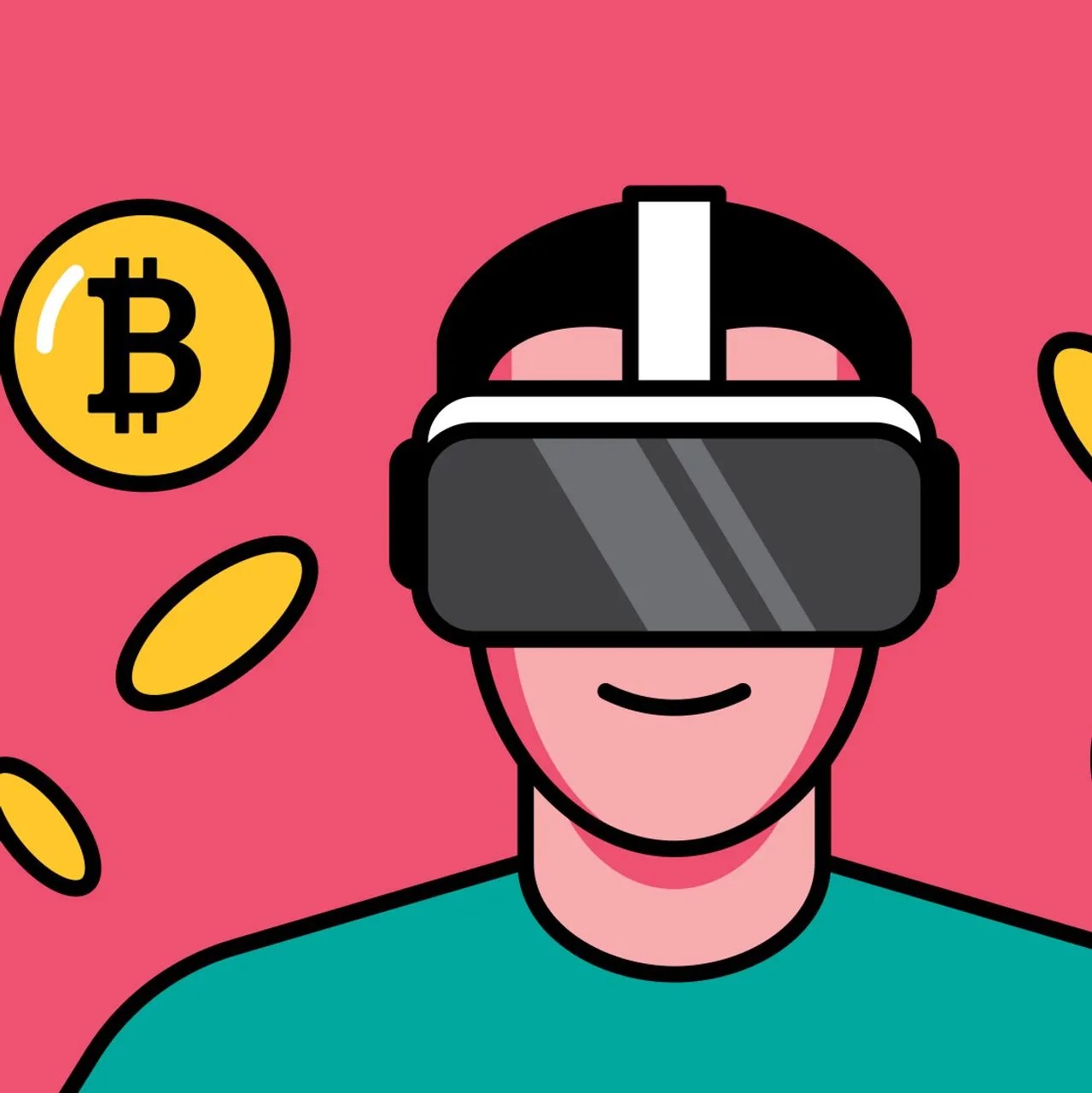The internet, both Web1 and Web2, changed our lives in profound ways. Once again we are on the brink of another big change. We are at a point of transition between technological evolutions that are going to change how we play, how we shop, how we hang out with friends, and even how we go to work.
Web3 and metaverse are emerging as the next-generation Internet.
Metaverse is the next-generation user interface of the Internet. Instead of seeing the Internet on a screen, we can put on our virtual reality headset and we can experience an alternative digital universe that’s immersive and makes us feel like we’re inside the Internet, rather than outside looking in.
Web3 is the next-generation operating model of the Internet. Instead of big companies owning our data and processing it with their algorithms, we can take back control and ownership. Powered by blockchain, Web3 lets us fully own our data, the content we create and the digital lives that we live.
And then we have bitcoin, the internet of money.
Bitcoin is digital money and over the years, it has shown us that it can have utility in the physical world as well as the virtual world. Bitcoin is a technology, a currency, and a payments network and exchange of value that is completely decentralized.
While the metaverse and cryptocurrencies are completely independent and can live without each other, they are complementary and together can be so much more. Cryptocurrencies are vital in facilitating transactions in the metaverse. The growth of crypto has the potential to fuel the growth of the metaverse and vice versa.
While no one can say exactly what the metaverse will look like, what we can say is that the metaverse has the potential to impact how crypto evolves.
In metaverses, people will play games, build things, socialize, work, and even trade and earn crypto assets.
All of these new virtual worlds have one thing in common: they all want us to spend money to buy, sell, and exchange virtual goods and services.
Convenience and speed were two of the key themes with the previous versions of the internet. We’ve all heard and used “one-click shopping” which provided us with a frictionless shopping experience. There is no reason why Web3 and metaverse are going to be any different.
The nature of the metaverse is friction-free.
Think about going somewhere in the real world and everything you need to do to get there. You need to buy tickets, pack your luggage, and make sure you have your passport with you. Now if you want to go someplace in the metaverse, all you have to do is press a button.
The same holds true for crypto.
Transacting with fiat money requires an infrastructure of intermediaries. On the other hand, cryptocurrency relies on a distributed and decentralized network that enables trustless transactions, without the need for an intermediary to supply the element of trust.
As the metaverse gains traction, spending money will become a lot easier because we will have a frictionless way to pay for virtual goods and services.
Eventually, it will be possible to buy and sell virtual goods from different games and universes on interoperable marketplaces. Someone might be able to sell their virtual plot of land in Decentraland and use the funds for example to purchase Fortnite skins. Cryptocurrencies could become the sole legal tender used in the metaverse, with all virtual objects and intangible items being expressed as NFTs.
PwC predicts that the metaverse will significantly contribute to the global economy, impacting sectors like education tech, health, and gaming. According to their findings, the metaverse ecosystem could be worth $1.5 trillion by 2030.
The metaverse will become the place where crypto gains mainstream adoption and where we start using cryptocurrencies as currencies.
This means that as more of us use crypto in the metaverse, we will also use it more and more outside of the metaverse, to pay for things and send money to others.
Practically, crypto will become a currency not just in the metaverse, but in the real world.
Now that metaverse projects are gaining steam, several metaverse cryptocurrencies have also emerged.
While these metaverse cryptos can be used to buy and sell things in the metaverse, they also represent a fantastic investment opportunity, because the majority of these tokens are offered at extremely low prices.
Decentraland’s MANA and The Sandbox’s SAND were among the top 10 best-performing cryptocurrencies in 2021, according to CoinMarketCap er, reflecting growing consumer demand to get in early on the metaverse.
Cryptocurrencies are a perfect fit for the currency of a virtual world. Cryptocurrencies, NFTs, and other blockchain-based digital assets will underpin value exchange across the metaverse.
But, rather than just viewing the metaverse as the future of crypto, we also need to look at crypto as a fundamental building block of the metaverse. Clearly, the metaverse is still an emerging and fast-growing area, but the truth is that in order to facilitate and realize a fully functioning metaverse, blockchain and cryptocurrencies will need to play a prominent role in its future.
Web3 and metaverse are emerging as the next-generation Internet.
Metaverse is the next-generation user interface of the Internet. Instead of seeing the Internet on a screen, we can put on our virtual reality headset and we can experience an alternative digital universe that’s immersive and makes us feel like we’re inside the Internet, rather than outside looking in.
Web3 is the next-generation operating model of the Internet. Instead of big companies owning our data and processing it with their algorithms, we can take back control and ownership. Powered by blockchain, Web3 lets us fully own our data, the content we create and the digital lives that we live.
And then we have bitcoin, the internet of money.
Bitcoin is digital money and over the years, it has shown us that it can have utility in the physical world as well as the virtual world. Bitcoin is a technology, a currency, and a payments network and exchange of value that is completely decentralized.
While the metaverse and cryptocurrencies are completely independent and can live without each other, they are complementary and together can be so much more. Cryptocurrencies are vital in facilitating transactions in the metaverse. The growth of crypto has the potential to fuel the growth of the metaverse and vice versa.
While no one can say exactly what the metaverse will look like, what we can say is that the metaverse has the potential to impact how crypto evolves.
In metaverses, people will play games, build things, socialize, work, and even trade and earn crypto assets.
All of these new virtual worlds have one thing in common: they all want us to spend money to buy, sell, and exchange virtual goods and services.
Convenience and speed were two of the key themes with the previous versions of the internet. We’ve all heard and used “one-click shopping” which provided us with a frictionless shopping experience. There is no reason why Web3 and metaverse are going to be any different.
The nature of the metaverse is friction-free.
Think about going somewhere in the real world and everything you need to do to get there. You need to buy tickets, pack your luggage, and make sure you have your passport with you. Now if you want to go someplace in the metaverse, all you have to do is press a button.
The same holds true for crypto.
Transacting with fiat money requires an infrastructure of intermediaries. On the other hand, cryptocurrency relies on a distributed and decentralized network that enables trustless transactions, without the need for an intermediary to supply the element of trust.
As the metaverse gains traction, spending money will become a lot easier because we will have a frictionless way to pay for virtual goods and services.
Eventually, it will be possible to buy and sell virtual goods from different games and universes on interoperable marketplaces. Someone might be able to sell their virtual plot of land in Decentraland and use the funds for example to purchase Fortnite skins. Cryptocurrencies could become the sole legal tender used in the metaverse, with all virtual objects and intangible items being expressed as NFTs.
PwC predicts that the metaverse will significantly contribute to the global economy, impacting sectors like education tech, health, and gaming. According to their findings, the metaverse ecosystem could be worth $1.5 trillion by 2030.
The metaverse will become the place where crypto gains mainstream adoption and where we start using cryptocurrencies as currencies.
This means that as more of us use crypto in the metaverse, we will also use it more and more outside of the metaverse, to pay for things and send money to others.
Practically, crypto will become a currency not just in the metaverse, but in the real world.
Now that metaverse projects are gaining steam, several metaverse cryptocurrencies have also emerged.
While these metaverse cryptos can be used to buy and sell things in the metaverse, they also represent a fantastic investment opportunity, because the majority of these tokens are offered at extremely low prices.
Decentraland’s MANA and The Sandbox’s SAND were among the top 10 best-performing cryptocurrencies in 2021, according to CoinMarketCap er, reflecting growing consumer demand to get in early on the metaverse.
Cryptocurrencies are a perfect fit for the currency of a virtual world. Cryptocurrencies, NFTs, and other blockchain-based digital assets will underpin value exchange across the metaverse.
But, rather than just viewing the metaverse as the future of crypto, we also need to look at crypto as a fundamental building block of the metaverse. Clearly, the metaverse is still an emerging and fast-growing area, but the truth is that in order to facilitate and realize a fully functioning metaverse, blockchain and cryptocurrencies will need to play a prominent role in its future.

Ilias Louis Hatzis
Ilias Louis Hatzis is the Founder & CEO at Mercato Blockchain Corporation AG.
Ilias Louis Hatzis is the founder and CEO at Kryptonio wallet. Create your wallet in less than a minute, without seed phrases, private keys, passwords or documents. Keep your bitcoin and digital assets always secure and recoverable: https://kryptonio.com
I have no positions or commercial relationships with the companies or people mentioned. I am not receiving compensation for this post.
Ilias Louis Hatzis is the founder and CEO at Kryptonio wallet. Create your wallet in less than a minute, without seed phrases, private keys, passwords or documents. Keep your bitcoin and digital assets always secure and recoverable: https://kryptonio.com
I have no positions or commercial relationships with the companies or people mentioned. I am not receiving compensation for this post.
Autres articles
-
Bpifrance intensifie sa stratégie d'investissement en cryptomonnaies
-
Fipto obtient l'agrément d'établissement de paiement de l'ACPR, renforçant sa position dans les paiements numériques
-
Epsor fait entrer le Fonds Stratégique des Transitions (FST) à son capital
-
Nomination | Banque Richelieu France renforce son équipe de banquiers privés
-
Cybersécurité et fintechs : face à la montée des attaques, comment renforcer la résilience ?







